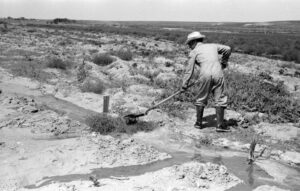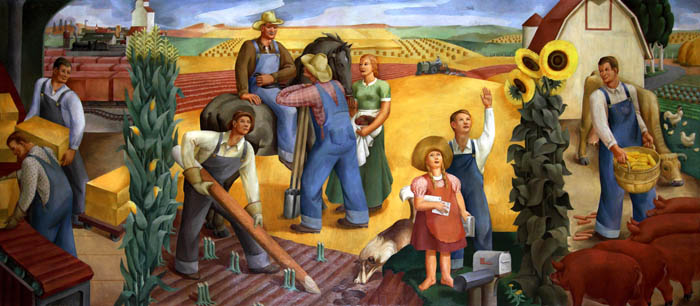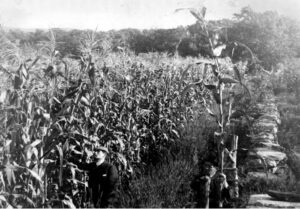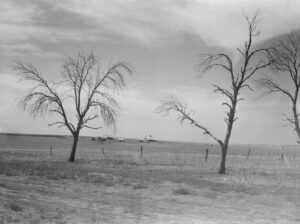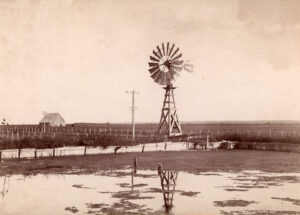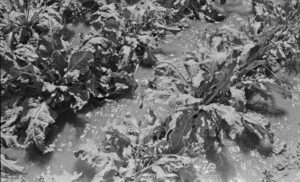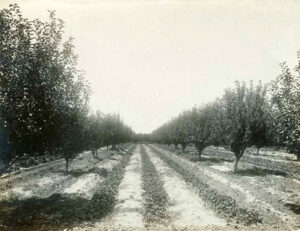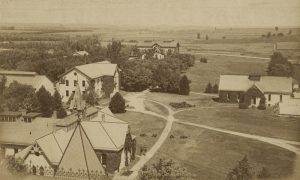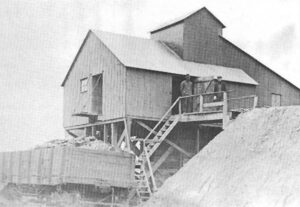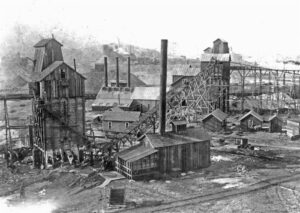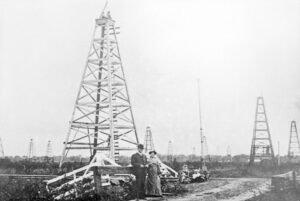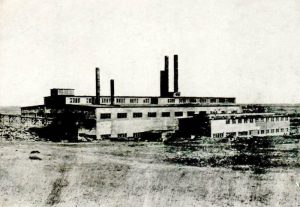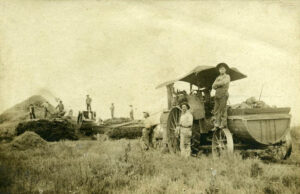
Co-operative Refining Co. in Chanute, Kansas, 1907.
The Earliest Kansas Farmers. Agriculture, our state’s leading industry, was almost our people’s only occupation for many years. The Indians were the first farmers in Kansas. The Comanche were roving hunters in the western part of the state, but the eastern Indians had permanent homes and tilled the soil. They were both hunters and farmers. In describing their mode of living, a government agent said: “They raise annually small crops of corn, beans, and pumpkins. These they cultivate entirely with the hoe, in the simplest manner. Their crops are usually planted in April and receive one dressing before they leave their villages for the summer hunt in May.”
Agriculture Taught to the Indians. When Kansas was made an Indian country, the National Government agreed in the treaties to supply the Indians with cattle, hogs, and farming implements and to employ persons to teach them agriculture. Under this agreement, several government farms were established, and the government farmers and the missionaries taught agriculture to the Indians. When Kansas was organized as a Territory in 1854, several farms were on different reservations and at the missions. The produce showed that the soil of Kansas was remarkably fertile.
Agriculture During Territorial Days. Most of the early settlers of Kansas were farmers, but during the Territorial days, the political and governmental troubles made much progress in farming impossible. The terrible season of 1860 made a dreary closing for this period. It confirmed in the minds of many eastern people that Kansas was fit only for Indians, buffalo, and prairie dogs.
Agriculture During the Civil War. The year following the drought brought a good crop but also the beginning of the Civil War, which absorbed the settlers’ energies for four more years. It was not until the close of the war, in 1865, that agriculture could be said to have had a real beginning in Kansas. But, despite the poverty and hardships of the war years, two things of special significance were done that showed the interest of the pioneers in agriculture. The Agricultural College at Manhattan was established during this period, and the State Agricultural Society was formed.
The object of the Society was “to promote the improvement of agriculture and its kindred arts throughout the State of Kansas.” Under its management, a state fair was held at Leavenworth in 1863, and in that year, the Legislature appropriated $1000 for the benefit of the Society. These events are worthy of note because they showed the enterprise of the people when their resources were small. Early Farming- Implements. The farming implements of the pioneers were few and simple. Much of the machinery of today had not then been invented. Because of transportation costs and the lack of money among the settlers, even the machinery of that day was scarce in Kansas. The all-important implement was the plow. The pioneer’s first crop was usually “sod corn.” The field was prepared with a breaking plow, which threw the sod in parallel strips from two to five inches in thickness.
Then the farmer, with an ax or a spade and a bag of seed corn, walked back and forth across the field, prying apart or gashing the sod at regular intervals and dropping into each opening three or four grains of corn; then he waited for the crop. Once the land was broken, the seed was prepared with the stirring plow and the harrow, and planting was done with a hand planter. Later, the corn planter drawn by a team came into use. This machine required a driver and another person to work the lever that dropped the corn. Then came the planter with the check rower, which made only a driver necessary when attached to the planter. The lister has come into very general use in the last few years. The early settlers cultivated corn with a single shovel cultivator drawn by one horse. With this cultivator, it was necessary to trip along each side of every row of corn. The double-shovel cultivator soon came into use, but it was also drawn by one horse and cultivated only one side of the row at a time. This labor was significantly reduced by the invention of the cultivator, which was drawn by a team and had shovels for both sides of the cornrow. Formerly, the farmer cut all his corn by hand with a knife. Now, he used the riding corn binder.
As corn machinery has improved, even more significant changes have occurred in the machinery used for the wheat crop. The earliest harvesting implement used in Kansas was the cradle, a scythe with long fingers parallel to the blade to catch the grain as it was cut. The cradler laid the grain in rows. A second man followed with a rake and gathered the wheat into small piles, which he tied into bundles, using some of the straw for bands. The next machine was the reaper, which carried two men to drive the team and push off the wheat whenever enough had been cut to make a bundle. The reaper required four or five binders to follow it. It was soon improved by being made self-dumping and, later, self-binding. Inventions and improvements have followed in rapid succession, and today, the planting and harvesting of wheat can be done with remarkable speed and efficiency. The many incredible inventions in farm machinery have made it possible in today’s farming to achieve significant savings of time and labor compared to 40 years ago. There are a few lines in which more significant progress has been made.
Agriculture Between 1860 and 1880. For several years after the Civil War, the population of Kansas increased more rapidly than the crops, and the country was kept poor. The destruction of crops by the grasshoppers in 1874 retarded immigration and left the people discouraged. However, several good crop years followed, and confidence in Kansas’s agricultural future soon returned. By 1880, nearly 9,000,000 acres of land were in cultivation, a third of which was planted to corn and a fourth to wheat. The next most extensive acreage was in oats. Several other crops were reported, including rye, barley, buckwheat, sorghum, cotton, hemp, tobacco, broom corn, millet, clover, and bluegrass. At that time, not a great deal was known of the state’s soil or climate; in this list of crops, several have since been found unprofitable and are no longer raised in any considerable quantities.
Agriculture from 1880 to 1887. The year 1880 found the people of Kansas full of hope and courage, and from that time until the drought of 1887, agriculture developed rapidly. It was a period of new ideas and new methods. Millions of additional acres were brought into cultivation. The principal crops, corn, wheat, and oats, increased significantly. Fields of timothy grass, clover, orchard grass, and bluegrass were planted in the central counties and even farther west. Soil that had been considered unfit for farming a few years before produced crops. The state was being rapidly settled, many miles of railroad were in operation, and the excellent crops encouraged the “boom” of 1885 to 1887.
Agriculture from 1887 to 1893. The period of good crops following the dry season of 1887 lasted for five years, and it was a time of great activity along many lines of agricultural advancement. By 1890, nearly 16,000,000 acres had been brought under cultivation. This area was almost double the area under cultivation ten years earlier.
Western Kansas. Before 1890, most of the farming was done in the eastern and central parts of the state, the western part being considered poorly adapted to agricultural purposes. However, during the next few years, it was shown that wheat could be successfully raised clear to the Colorado line. The sorghum crops also proved to be well adapted to this section. The soil of western Kansas was wonderfully fertile, needing only moisture to produce it abundantly. A more thorough understanding of soil and climate brought better tillage methods, and this, together with a careful selection of crops, made the yield much larger and more certain.
Irrigation in Western Kansas. The irrigation possibilities for this section of the country have long been considered. For several years, water from the Arkansas River was successfully used. In developing irrigation, Colorado used so much water from the upper Arkansas River that there was not enough left for our state. Investigation resulted in the discovery of an underground water supply. This water, called the underflow, moves eastward from the Rocky Mountains through strata of gravel and sand.
It offers a large part of western Kansas a practically inexhaustible water supply for irrigation. Wells are bored into this underflow, and the water is pumped for irrigation. Only a small part of western Kansas is under irrigation in the early 20th century. However, experiments to find individuals, experiment stations, and the state, using the best methods of underflow, increased irrigation in the state, and irrigation by pumping brought about a remarkable agricultural advancement in western Kansas.
Alfalfa. About 1890, several new crops became prominent in Kansas, the most important of which was alfalfa. Alfalfa began to grow in every Kansas county and became one of our foremost crops. Because of its long, penetrating roots, it can be grown successfully without irrigation, even in most of the drier parts of Kansas. As its many points of excellence became better known, its acreage constantly increased. Within a short time, Kansas produced more alfalfa than any other state. Sweet clover and Sudan grass increased so much in acreage that they rapidly became important crops in this state.
The Sorghum Crops. Another of the new crops was Kafir corn, which has also proved very valuable. This plant is a variety of sorghum. Other varieties had been raised in Kansas for many years, especially the sweet sorghum that could be used for making sugar and molasses. Broom corn is another sorghum crop grown in Kansas for a long time and raised in large quantities in the southwestern part of the state. In recent years, two more sorghums, milo and feterita, promised to become valuable forage crops.
Sugar Beets. During the early 1880s, considerable sugar had been made from sorghum cane, but in 1889, it was made from beets for the first time. Experiments were made with sugar beets in different parts of western Kansas for several years. The state offered a bounty to encourage sugar beet raising, and many tons were raised and shipped to sugar factories in Colorado and Nebraska. In 1906, a large factory was completed in Garden City, and the raising of sugar beets became an important industry in that part of Kansas. Efforts were then made to introduce this crop into other parts of the state.
The Twenty-five Years Following 1893. Progress was checked in 1893 by the financial panic that extended throughout the country. Values dropped, and prices were low on everything the farmers had to sell. In addition to the panic, Kansas suffered a crop failure in most of the state. That was a discouraging period, but within a few years, Kansas had recovered. Afterward, there was a steady rise in all values. Land prices steadily rose due to the fact that there was no longer any free land to be taken as homesteads. The price of land products also significantly increased. In 1893, corn was worth ten to fifteen cents a bushel, and wheat was worth 30 to 40 cents.
Kansas Wheat. By the 1920s, Kansas was one of the leading agricultural states in the country. It produced a greater variety of crops than almost any other state, but the principal ones were, as they have been from the earliest days, corn and wheat. Alfalfa came to be a close third. Wheat was our most noted crop, and Kansas was unsurpassed in producing this grain. Wheat is grown in every county in the state, but by far, the most significant quantity comes from the “wheat belt,” which extends across the middle of the state, from north to south. Most Kansas wheat is of the winter varieties commonly called “Turkey wheat,” first brought here from southern Russia by the Mennonites in 1873.
The Corn Crop. Corn was raised here by the Indians, and from the time of the settlement of the Territory until the early 20th century, it was the leading crop and the most significant source of Kansas wealth. Since 1913, however, wheat has become the state’s most valuable crop, and corn has had to take second place. Corn is raised in all parts of the state, but the largest portion is produced in the eastern half. Kansas’s great livestock industries depend on this crop most of the time.
The Livestock Industry. The livestock industry is one of the state’s most important interests. The grain and forage crops, the large areas of good pasture, the plentiful supply of water, and the nearness to market all combine to make Kansas an excellent livestock region. The raising and fattening of cattle and hogs constitute the chief features of this industry, although there are several others, prominent among which is dairying. The early farmers had their herds and flocks but paid little attention to quality or breeds. In time, it was found that better grades were more profitable, and the early-range cattle and the scrub stock of the pioneers disappeared.
When the Union Pacific Railroad was built, the cattlemen of Texas began driving their cattle into Kansas to ship them to market. For many years, Abilene was the shipping center. When the Atchison, Topeka & Santa Fe Railroad was built, Wichita became the chief shipping point, being farther south. The cattle trade was pushed farther west as the country was more settled. Finally, it reached Dodge City, which remained the shipping center for many years. The building of railroads into the Southwest made it unnecessary for the Texas cattlemen to drive their stock to a Kansas shipping point, and in about 1885, the practice was abandoned. While the trade flourished, the cowboy, with his boots, spurs, and broad-brimmed hat, was a familiar figure on the plains of western Kansas, but as the settlers turned the grazing land into farms, the cowboy moved farther west.
Horticulture. Another Kansas industry is horticulture, which is the cultivation of fruits. The first orchard in Kansas was planted at Shawnee Mission in 1837. However, minimal tree planting was done until after the Civil War, and even then, the Kansas plains were regarded as unfit for fruit growing for many years. The early crops were small but of fine quality, and Kansas apples won the gold medal at the Centennial Exposition in Philadelphia, Pennsylvania, in 1876. This aroused much enthusiasm, and during the next few years, many thousands of fruit trees were planted, but most of them proved worthless because the varieties were not adapted to conditions in this state. Long years of hard work and patient effort were required to secure the knowledge necessary to make a prosperous state of Kansas. Many fruits were grown here by the early 20th century, but the Kansas apple was famous. Scarcely a farm in the eastern and central parts of the state was without its orchard, and several commercial orchards made horticulture an essential industry in Kansas.
Farmers’ Organizations. The state farmers formed several organizations at different times, especially in the early years. An early organization was the Order of Patrons of Husbandry or the “Grange,” a national movement introduced in Kansas in 1872. Its general purpose was the improvement of farm life. Many Granges were organized during the 1870s. The Farmers’ Cooperative Association, begun in 1873, and the Farmers’ Mutual Benefit Association in 1883, had for their general purposes the cooperation of the farmers in buying and selling and securing lower freight rates.
In about 1888, the Farmers’ Alliance, already a national organization, formed many local organizations in Kansas. The Alliance demanded several measures for the betterment of the farmers, including lower freight and passenger rates and better mortgage, debtor, and tax laws. The Farmers’ Alliance was a widespread movement and, for a time, overshadowed all other farmers’ organizations. In 1890, the People’s Party, or the Populist Party, as it came to be called, took over the potential work of the Farmers’ Alliance, and that organization gradually disappeared. The Farmers’ Educational and Cooperative Union of Kansas came later.
The State Board of Agriculture. In 1872, the Agricultural Society, organized during the Civil War, was changed into the State Board of Agriculture. For several years, this Board gave special attention to gathering and distributing information concerning the state’s resources to stimulate immigration. Later, it began furnishing farmers with information concerning methods of farming best adapted to Kansas conditions. These activities continued, and the Board of Agriculture was of great practical value to the state.
Work of the Agricultural College. The Agricultural College (Kansas State University today), in its early years, laid but slight stress on agricultural and industrial work. However, in 1873, its work plan was changed, and it soon began to fulfill its fundamental mission. A few years later, the usefulness of the College was significantly increased by the establishment of an experiment station where investigations are carried out in such matters as the testing of seeds, the introduction of new crops, the rotation of crops, dairy and animal husbandry, butter and cheese making, orchard and crop pests, stock foods, and diseases of livestock. In later years, branch experiment stations were established at Hays, Garden City, Dodge City, Tribune, and Colby, where problems peculiar to the western part of the state are studied. The Agricultural College was gathering information and bringing it to the people using bulletins, lectures, correspondence courses, demonstration trains, demonstration agents, and farmers’ institutes. Kansas was one of the first states to hold a Farmers’ Institute in connection with its Agricultural College. This work was begun in 1869, and the purpose was then, as it is today, to promote the knowledge of scientific agriculture.
Manufactures Based on Agriculture. Kansas’s agricultural resources have led to the development of several manufacturing industries. One of the oldest of these is milling. Among the first needs of the settlers of the new country was a means of grinding their corn and wheat into meal and flour for family use. This caused the building of small gristmills in every community. Most of them were built along streams and run by water power, though a few early ones used wind power. In later years, steam has generally been used. After the introduction of hard wheat, the wheat crop became much more certain, the acreage increased, and the milling industry grew. Kansas flour is now sold in all the world’s important markets, and Kansas is one of the leading states in the milling industry.
Meatpacking has held first place among Kansas’s manufacturing industries for decades. Kansas City, once the second-greatest packing center in the United States, was the chief market for Kansas livestock for many years. Still, several packing houses were located in different parts of the state. Creameries, canning factories, and pickling works represent other industries that have been developed to use our agricultural products.
The Mineral Industries. Although Kansas is not one of the great mining states, it has several valuable mineral resources: coal, lead, zinc, oil, gas, salt, building stone, and gypsum. These resources form an essential part of the state’s industrial life. Coal and gas have made several manufacturing industries possible.
Coal. As early as the Territorial period, it was known that there were coal fields in Kansas, and small amounts of coal were mined in Crawford and Cherokee Counties. Immediately after the Civil War, the settlers in the southeastern part of the state gave much attention to digging coal, some of which lay so near the surface that it could be uncovered with a plow. Within the next few years, coal was found in Osage and Leavenworth Counties and the vicinity of Fort Scott. These places produced large amounts, but Crawford and Cherokee counties soon became the state’s leading coal districts. In the 1910s, about nine-tenths of the Kansas output was mined in these two counties. The importance of the coal fields of Kansas lies not only in the value of the coal but also in the stimulation of the growth of manufacturers. Many industries relied heavily on large amounts of fuel to supply power. The development of several such industries in Kansas was made possible chiefly by the cheap and abundant coal supply.
Lead and Zinc. Before Kansas was organized as a Territory, lead mining was an important industry in southwest Missouri, but not until 1876 was it discovered that the lead and zinc field extended into the southeast corner of Kansas. Prospecting began immediately, and thousands of people were soon on the ground. Although zinc was abundant with lead, little attention was paid to it. Within a few years, however, it was found that the abundance of coal made the smelting of zinc profitable, and zinc soon assumed the leading place. For several years, much more zinc than lead has been produced.
A large amount of ore from the Missouri mines was shipped to the Kansas smelters, and the smelting of lead and zinc, particularly zinc, became one of the most important mineral industries. The development of the gas field furnished a cheaper and more abundant fuel than coal, and much of the smelting was soon being done where gas could be used. In later years, gas was less abundant, and there was a tendency to return to the use
of coal.
Oil and Gas. Although prospecting had been done earlier, the actual development of oil and gas in Kansas began about 1892, with the discovery of the big Kansas-Oklahoma field. The oil and gas area is within an irregular strip, 40-50 miles wide, extending from Kansas City southwesterly into Oklahoma. It is frequently spoken of as the “oil and gas belt.” By 1900, nearly every town in the gas belt had more gas than it knew what to do with, and various manufacturing enterprises, such as brick plants, zinc smelters, glass factories, and Portland cement mills, were soon attracted to these towns. A little later, gas was supplied to cities outside the gas belt. Pipelines were laid to Wellington, Wichita, Hutchinson, Topeka, Lawrence, Kansas City, Leavenworth, Atchison, and many other towns. After ten years of this significantly increased use of gas, the supply became less abundant, and now it is feared that the supply from this field may fail at no distant date.
In the earlier years, the oil was all carried in tank cars, but a pipeline system was soon laid. Many refineries were soon established. The crude oil is used chiefly for fuel and machine oil. In the refineries, it is made into benzine, gasoline, and kerosene. Vaseline and paraffin are among the by-products. In 1914, oil and gas were discovered in Butler County. Within two years, this field yielded such large quantities of oil that the state’s total production doubled. During the following year, 1917, more than three times as much oil was produced as in 1916, and Kansas had become the greatest oil-producing state in the Union. The output of the Butler County field is still increasing, and its remarkable yield will probably continue for several years.
Salt. Salt is found in Kansas as a brine in the salt marshes and as beds of rock salt lying beneath the surface. The marshes were known to the early hunters and settlers, and through the early years of statehood, a little salt was manufactured from this brine. In the late 1880s, rock salt beds were discovered, and the salt-making industry was rapidly developed. The center of the salt industry is now, as it has been from the beginning, at Hutchinson. Salt is found in many parts of Kansas, but the most valuable area extends north to south across the state’s middle. In most places, this great salt bed is from 250 to 400 feet thick. Some salt is made by crushing the rock salt, but the evaporation makes up a more significant portion of the brines. The brines are obtained by forcing a stream of water through rock salt.
Brick. Brickmaking in Kansas dates from the early years. Brick clays are found in many parts of the state, but the industry is carried on chiefly in the eastern part of the state, especially in the gas belt, because of the fuel supply.
Gypsum. Gypsum beds are found in central Kansas, especially around Blue Rapids and Saline, Dickinson, and Barber Counties. Plaster of Paris, used chiefly for making plaster for covering wall surfaces, is made from gypsum.
Portland cement is a comparatively new product in the United States. The development of this industry in Kansas commenced in about 1900. Portland cement is made from certain mixtures of rock substances put through grinding and heating processes. Its chief use is making concrete, which is widely used for construction work. There were several Portland cement mills in the gas belt.
Glass. Gas is the most satisfactory fuel for glassmaking, and since the gas field in Kansas was opened, several glass factories have been established in the state. Good-quality sand for making glass is also found in southeastern Kansas.
Agriculture: The Basis of Material Progress. In 1920, many Kansas factories engaged in many different lines of work. Our industries are constantly growing in number and importance, and it takes all of them to make a well-rounded state. However, the agricultural industries form the basis of our prosperity.
Summary. The principal agricultural industries of the state are farming, stockraising, and horticulture. The principal mineral industries were coal, lead, zinc, oil, gas, salt, building stone, and gypsum. The leading manufacturing industries are primarily concerned with agricultural and mineral products, carried on most extensively in the coal and gas regions. Droughts in all agricultural regions have been most severe in Kansas in the following years: 1860, 1869, 1874, 1887, 1893, and 1913. These years have marked periods of what has otherwise been steady progress in agriculture.
The Agricultural Society, organized during the Civil War, was changed into the State Board of Agriculture in 1872. The Agricultural College, established during the Civil War, began active work along agricultural lines in 1873. Several farmers’ organizations have existed, most of them between 1870 and 1890. Agriculture has advanced in areas such as under cultivation, crop selection, machinery improvements, and better methods of tillage and irrigation. The leading crops in 1920 were corn, wheat, and alfalfa.
Compiled & edited by Kathy Alexander/Legends of America, updated August 2025. Source: Arnold, Anna E.; The State of Kansas; Imri Zumwalt, state printer, Topeka, Kansas, 1919.
Also See:

